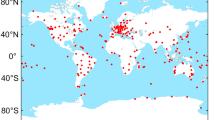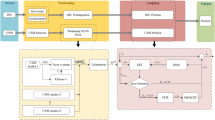Abstract
We address the Bayesian sensor fusion approach for distributed location estimation in the wireless sensor network. Assume each sensor transmits local calculation of target position to a fusion center, which then generates under a Bayesian framework the final estimated trajectory. We study received signal strength indication-based approach using the unscented Kalman filter for each sensor to compute local estimation, and propose a novel distributed algorithm which combines the soft outputs sent from selected sensors and computes the approximated Bayesian estimates to the true position. Simulation results demonstrate that the proposed soft combining method can achieve similar tracking performance as the centralized data fusion approach. The computational cost of the proposed algorithm is less than the centralized method especially in large scale sensor networks. In addition, it is straightforward to incorporate the proposed soft combining strategy with other Bayesian filters for the general purpose of data fusion.









Similar content being viewed by others
References
Khaleghi, B., Khamis, A., Karray, F., & Razavi, S. (2013). Multisensor data fusion: A review of the state-of-the-art. Information Fusion, 14(1), 28–44.
Castanedo, F. (2013). A review of data fusion techniques. The Scientific World Journal. https://doi.org/10.1155/2013/704504.
Kong, L., Peng, X., Chen, Y., Wang, P., & Xu, M. (2020). Multi-sensor measurement and data fusion technology for manufacturing process monitoring: A literature review. International Journal of Extreme Manufacturing. https://doi.org/10.1088/2631-7990/ab7ae6.
Zhao, Z., Zheng, P., Xu, S., et al. (2019). Object detection with deep learning: A review. IEEE Transactions on Neural Networks, 30(11), 3212–3232.
Ahn, K., & Kang, Y. (2019). A particle filter localization method using 2D laser sensor measurements and road features for autonomous vehicle. Journal of Advanced Transportation. https://doi.org/10.1155/2019/3680181.
Zhang, C., Yan, H., Lee, S., & Shi, J. (2018). Multiple profiles sensor-based monitoring and anomaly detection. Journal of Quality Technology, 50(4), 344–362.
Saxena, M., Gupta, P., & Jain, B. N. (2008). Experimental analysis of RSSI-based location estimation in wireless sensor networks. In 2008 3rd international conference on communication systems software and middleware and workshops (COMSWARE ’08), Bangalore, 2008 (pp. 503–510).
Zhang, W., & Yang, X. (2014). RSSI-based node localization algorithm for wireless sensor network. Journal of Chemical and Pharmaceutical Research, 6(6), 900–905.
Maduskar, D., & Tapaswi, S. (2017). RSSI based adaptive indoor location tracker. Scientific Phone Apps and Mobile Devices 3, June 2017.
Wu, Z., Jedari, E., Muscedere, R., & Rashidzadeh, R. (2016). Improved particle filter based on WLAN RSSI fingerprinting and smart sensors for indoor localization. Computer Communications, 83, 64–71.
Chen, J. (2011). RSSI-based indoor mobile localization in wireless sensor network. International Journal of Digital Content Technology and its Applications, 5(7), 407–416.
Vadivukkarasi, K., Kumar, R., & Joe, M. (2015). A real time RSSI based novel algorithm to improve indoor localization accuracy for target tracking in wireless sensor networks. ARPN Journal of Engineering and Applied Sciences, 10(16), 7015–7023.
Kanhere, O., & Rappaport, T. (2018). Position locationing for millimeter wave systems. In IEEE global communications conference, 2018.
Yu, L., Hou, C., Li, X., & Yuan, K. (2012). An indoor positioning system based on ToF for wireless sensor networks. In IET International Conference on Information Science and Control Engineering 2012 (ICISCE 2012), Shenzhen (pp. 1–6).
Bao, Z., Bowen, L., & Zhang, W. (2019). Robustness of ToF and stereo fusion for high accuracy depth maps. DEStech Transactions on Computer Science and Engineering, 13, 676–681.
Kang, C., Lee, H., & Oh, C. (2009). NLOS signal detection algorithm for TDOA method in wireless sensor network. In 2009 11th international conference on advanced communication technology, Phoenix Park (pp. 901–904).
Jiang, J., Ren, J., & Wang, Q. (2016). A target location algorithm based on seismic waves for wireless sensor networks. In 2016 3rd international conference on systems and informatics (ICSAI), Shanghai (pp. 45–49).
Gezici, S., et al. (2005). Localization via ultra-wideband radios: a look at positioning aspects for future sensor networks. IEEE Signal Processing Magazine, 22(4), 70–84.
Peng, X., Yang, K., & Liu, C. (2015). Maneuvering target tracking using current statistical model based adaptive UKF for wireless sensor network. Journal of Communications, 10(8), 579–588.
Kalman, R. (1960). A new approach to linear filtering and prediction problems. Journal of Basic Engineering, 82, 35.
Caceres, M., Sottile, F., & Spirito, M. (2009). Adaptive location tracking by Kalman filter in wireless sensor networks. In WiMob 2009—5th IEEE international conference on wireless and mobile computing networking and communication (pp. 123–128).
Julier, S. J., & Uhlmann, J. K. (2004). Unscented filtering and nonlinear estimation. Proceedings of the IEEE, 92(3), 401–422.
Yin, Y., Huang, Y., & Zhang, J. (2004). Joint symbol detection and timing estimation with stochastic M-algorithm. In 2004 IEEE international conference on acoustics, speech, and signal processing (ICASSP), Montreal, May 2004 (pp. 845–848).
Conti, A., Mazuelas, S., Bartoletti, S., Lindsey, W. C., & Win, M. Z. (2019). Soft information for localization-of-things. Proceedings of IEEE, 107(11), 2240–2264.
Win, M. Z., Meyer, F., Liu, Z., Dai, W., Bartoletti, S., & Conti, A. (2018). Efficient multi-sensor localization for the internet-of-things. IEEE Signal Processing Magazine, 35(5), 153–167.
Arasaratnam, I., & Haykin, S. (2009). Cubature Kalman filters. IEEE Transactions on Automatic Control, 54(6), 1254–1269.
Huang, J., Yan, B., & Hu, S. (2015). Centralized fusion of unscented Kalman filter based on Huber robust method for nonlinear moving target tracking. Mathematical Problems in Engineering. https://doi.org/10.1155/2015/291913.
Yin, Y., Li, G., & Wei, H. (2017). Distributed probabilistic data association detector with turbo base-station cooperations in multi-user multi-cell MIMO systems. EURASIP Journal on Wireless Communications and Networking. https://doi.org/10.1186/s13638-017-0865-8.
Petersen, K. B., & Pedersen, M. S. (2012). The matrix cookbook. Kongens Lyngby: Technical University of Denmark.
Acknowledgements
This work is partly supported by Chengdu Technological University (Grant No. 2020ZZ004) and Sichuan Provincial Department of Science and Technology (Grant No. 18YYJC1705).
Author information
Authors and Affiliations
Corresponding author
Ethics declarations
Conflict of interest
The authors declare that they have no conflict of interest.
Additional information
Publisher's Note
Springer Nature remains neutral with regard to jurisdictional claims in published maps and institutional affiliations.
Rights and permissions
About this article
Cite this article
Yin, Y., Wang, Q., Zhang, H. et al. A Novel Distributed Sensor Fusion Algorithm for RSSI-Based Location Estimation Using the Unscented Kalman Filter. Wireless Pers Commun 117, 607–621 (2021). https://doi.org/10.1007/s11277-020-07888-w
Accepted:
Published:
Issue Date:
DOI: https://doi.org/10.1007/s11277-020-07888-w




